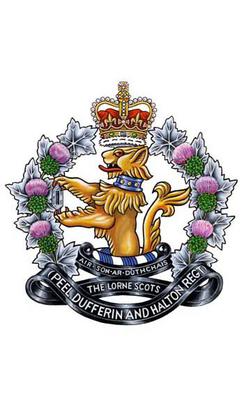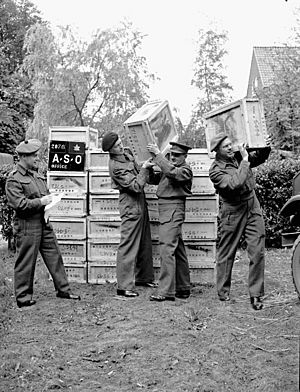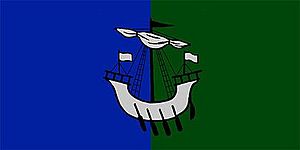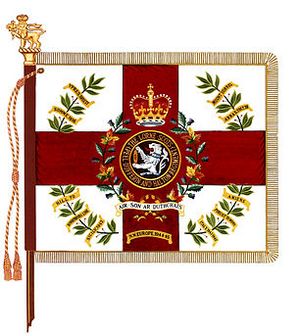The Lorne Scots (Peel, Dufferin and Halton Regiment) facts for kids
Quick facts for kids The Lorne Scots(Peel, Dufferin and Halton Regiment) |
|
|---|---|
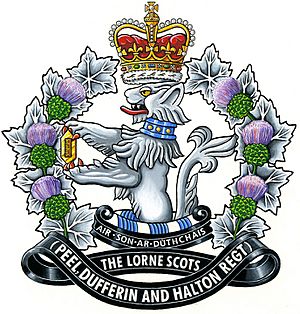
The cap badge of The Lorne Scots
(Peel, Dufferin and Halton Regiment). |
|
| Active | 14 September 1866 – present |
| Country | |
| Branch | Canadian Army |
| Type | Line Infantry |
| Role | Light Infantry |
| Size | One battalion |
| Part of | 32 Canadian Brigade Group 4th Canadian Division |
| Garrison/HQ | RHQ – Brampton, Ontario Admin Company – Brampton Halton Coy 1 Plt- Oakville, Ontario Peel Coy – Brampton Halton Coy 7 Plt Georgetown, Ontario Pipes & Drums Band – Georgetown |
| Motto(s) | Air son ar duthchais (For our heritage) (Scottish Gaelic) |
| March | Quick: The Campbells Are Coming Quick: John Peel |
| Mascot(s) | Wild Boar |
| Anniversaries | September 14, Regimental Birthday |
| Engagements | South African War World War I World War II UN Peacekeeping Operations NATO Operations War on Terror |
| Commanders | |
| Current commander |
LCol Robert Fraser, CD |
| Colonel-in-Chief | Field Marshal HRH The Duke of Kent |
| Insignia | |
| Tartan | Ancient Ordinary Campbell |
| Facings | White |
| Hackle | Primerose |
| Colours | Blue, Grey, and Green |
The Lorne Scots (Peel, Dufferin and Halton Regiment) is a special kind of army unit in Canada. It's part of the Canadian Army's reserve force, meaning its members train part-time but can be called upon for full-time duty. This regiment is part of the 4th Canadian Division's 32 Canadian Brigade Group.
Contents
How the Regiment is Organized
The Lorne Scots has different groups, called sub-units, located in various towns:
- Regimental Headquarters (RHQ): Brampton, Ontario
- Dufferin Company (Admin Coy): Brampton and Georgetown, Ontario
- Halton Company: Oakville and Georgetown, Ontario
- Peel Company (Peel Coy): Brampton
- Pipes and Drums (Dufferin Company): Georgetown
The current leader of the regiment is Lieutenant Colonel Robert Fraser. The most senior non-commissioned officer is Chief Warrant Officer Matthew Colbeck.
Since World War II, many soldiers from the Lorne Scots have served in peacekeeping missions around the world. They've been to places like the Middle East, Golan Heights, Namibia, Cambodia, Cyprus, the Former Yugoslavia, and Afghanistan.
Regiment's History and Name Changes
The Lorne Scots started in Brampton, Ontario, on September 14, 1866. It was first known as the 36th "Peel Battalion of Infantry." Over the years, its name changed several times.
Another important group, The Lorne Rifles (Scottish), began in Milton, Ontario, on September 28, 1866. It was called the 20th "Halton Battalion of Infantry." This group also changed its name many times.
Finally, on December 15, 1936, these two groups, The Peel and Dufferin Regiment and The Lorne Rifles (Scottish), joined together. This is how they became the regiment we know today: The Lorne Scots (Peel, Dufferin and Halton Regiment).
Honoring Past Units
The Lorne Scots keeps alive the memory and traditions of several older Canadian army units. This is called "perpetuation." It means they carry on the history and battle honors of these units, including:
- The 37th Battalion (Northern Ontario), CEF
- The 74th Battalion, CEF
- The 76th Battalion, CEF
- The 126th Battalion (Peel), CEF
- The 164th Battalion (Halton and Dufferin), CEF
- The 234th Battalion (Peel), CEF
They also carry battle honors from the 2nd Regiment of York Militia and the 4th Battalion, CEF.
Regimental Badges
Regimental badges are symbols that represent the unit and its history.
Cap Badge
The cap badge is worn on the uniform hat. It shows a silver lion holding a golden shuttle. This is surrounded by maple leaves and thistles, with scrolls that say "AIR SON AR DUTHCHAIS" (which means "For our heritage" in Scottish Gaelic) and "THE LORNE SCOTS (PEEL, DUFFERIN AND HALTON REGT)". The Royal Crown sits at the top.
The cap badge was updated in 2016 to look more like the image on the regiment's flag.
Collar Badge
The Lorne Rifles (Scottish) were given special permission in 1931 to wear the crest of the Chief of the Clan Campbell, the Duke of Argyll. This crest is a "Boar's head." You can see the boar's head on the collar of some of the regiment's uniforms.
A Look at Their History
The 36th Peel Battalion and the 20th Halton Battalion of Infantry were among Canada's early militia regiments. These two groups eventually combined to form The Lorne Scots.
The Scottish connection began in 1879 when the Halton Rifles were reviewed by The Marquis of Lorne. In 1881, they were allowed to change their name to the 20th Halton Battalion Lorne Rifles. They also started wearing tartan pants and a special Scottish hat called a Glengarry, and a Pipe Band was formed.
First World War Service
During the First World War, many Canadian battalions were formed. The Lorne Scots perpetuates several of these, meaning they carry on their legacy. These battalions often sent soldiers to help the main Canadian forces fighting overseas.
For example, the 74th Battalion was formed mainly from Peel county. It trained in Canada before its soldiers were sent to reinforce other units fighting in France. The 76th Battalion also sent many soldiers overseas.
The 126th Battalion (Peel), CEF, was formed in 1915. It had over a thousand men and 32 officers. This unit also trained in Canada before its members were used to reinforce other Canadian units due to heavy losses in battles like the Somme. The 126th's regimental march, 'John Peel', was later adopted by the Peel and Dufferin Regiment.
The 164th Battalion (Halton and Dufferin), CEF, recruited from Halton and Dufferin counties. It also sent its soldiers to reinforce Canadian units already fighting in France.
The 234th Battalion (Peel), CEF, was another unit formed during this time. It faced challenges in recruiting enough men but eventually sent its soldiers overseas to join other reserve battalions.
Besides these specific battalions, the 36th Peel Regiment and the 20th Halton Rifles also sent many officers and soldiers to other Canadian units fighting in the war.
Between the World Wars
After the First World War, the county regiments needed to be rebuilt. The 36th Peel Regiment was reorganized as the Peel Regiment. It later became The Peel and Dufferin Regiment in 1923, drawing members from both counties.
In 1923, the regiment was allowed to use part of the crest of Sir Robert Peel (after whom Peel county was named) as their badge. This crest included a "demi-lion" (half a lion) holding a shuttle.
In 1931, The Halton Rifles became The Lorne Rifles (Scottish). They received permission to use the "Boar's Head" crest and the "Ordinary Campbell" tartan from the Duke of Argyll.
On December 15, 1936, The Lorne Rifles and The Peel and Dufferin Regiment joined together to form The Lorne Scots (Peel, Dufferin and Halton Regiment).
World War II Service
When World War II began in 1939, the Lorne Scots quickly formed a unit called the No. 1 Infantry Base Depot, CASF. This unit helped manage Canadian soldiers arriving and leaving England.
They were stationed in Liverpool, England, which was a major port. Liverpool was heavily bombed during the war. The soldiers from the depot, even those waiting to return to Canada, bravely helped civil defense workers. They rescued people from ruined buildings, helped put out fires, and guided traffic during air raids. One of their medical officers, Captain D.C. Heggie, was even awarded the George Medal for his bravery in helping wounded civilians during a bombing raid.
The regiment also formed the 1st Battalion, The Lorne Scots (Peel, Dufferin and Halton Regiment), CASF in 1941. This battalion provided soldiers for "Defence and Employment" roles for the Canadian Army. These Lorne Scots units served in the Mediterranean, North-West Europe, and Canada.
Dieppe Raid
During the Dieppe Raid in 1942, some Lorne Scots soldiers were part of defense platoons. They landed on the beaches and faced heavy enemy fire. Many were reported missing, wounded, or captured. They showed great courage in helping their comrades and fighting until ordered to retreat.
Protecting Headquarters
In 1942, as the Canadian military grew in Britain, the Headquarters First Canadian Army, Defence Company (Lorne Scots) was created. Their job was to protect the main army headquarters. They trained hard, practicing for gas attacks and range shooting. They also provided honor guards for important visitors.
Fighting in Italy
Canadian troops were sent to Italy in 1943 to gain battle experience. The Lorne Scots' Defence Company joined the I Canadian Corps in Italy. They took over defensive positions and participated in patrols to gather information about the enemy.
One patrol described the tension of moving through enemy territory at night, avoiding tripwires and flares. They had to be very quiet and work as a team. Another story tells of a sergeant major who bravely brought rum to the front lines under shell fire, making sure his men were supplied.
Defending Canada
In 1942, there were fears of invasion on Canada's Pacific coast after Japanese submarines shelled parts of the US and a wireless station on Vancouver Island. The Canadian government formed units for home defense.
No. 6 Defence and Employment Platoon for the 6th Canadian Division was formed and recruited in the Lorne Scots' home areas. These soldiers trained and were posted to various locations, including British Columbia, to help defend the coast. By late 1944, as the need for coastal defense lessened, many of these soldiers were sent overseas.
After the Wars
Since World War II, the Lorne Scots have continued to be an active and important part of the Canadian Army. They are known for their excellent marksmanship, winning many shooting competitions at local and national levels. Some members have even competed in world championships and the Olympics.
In the 1960s, their allied regiment in England, the Lancashire Fusiliers, gave the Lorne Scots their special "primrose hackle" (a feather plume) to keep. Lorne Scots infantry soldiers proudly wear this on their headdress today.
The regiment's first Colonel-in-Chief, Field Marshal HRH The Duke of Kent, has visited the regiment several times. He presented them with new regimental and Queen's colors in 1991 for their 125th birthday.
The Lorne Scots have also sent soldiers to many United Nations peacekeeping missions, including the Golan Heights, Namibia, Cambodia, Cyprus, and the Former Yugoslavia. They helped with cleanup after the 1998 Ice Storm in eastern Ontario and participated in Operation Nanook in the Canadian Arctic. Soldiers also helped with security for the 2010 G20 Toronto Leaders Summit.
The Duke of Kent visited again in 2016 for the regiment's 150th birthday. More recently, the regiment has sent soldiers to help in the fight against ISIL and to train local forces in Jordan and Ukraine.
War in Afghanistan
From 2002 to 2014, over 20% of the Lorne Scots' soldiers served in Afghanistan. One soldier from the regiment received the new Sacrifice Medal for his service there.
Battle Honors
Battle honors are special awards given to military units for their bravery and success in battles and campaigns. The ones in Bold Type are proudly displayed on the regiment's flag.
War of 1812
The Great War (World War I)
- YPRES, 1915, '17
- Festubert, 1915
- MOUNT SORREL
- SOMME, 1916
- ARRAS, 1917, '18
- HILL 70
- AMIENS
- HINDENBURG LINE
- PURSUIT TO MONS
The Second World War
War In Afghanistan
The Regimental Pipes and Drums
The Lorne Scots has its own military pipe band! It's called The Regimental Pipes and Drums of The Lorne Scots (Peel, Dufferin and Halton Regiment). This band was formed way back in 1881, making it one of the oldest pipe bands in Canada.
The band plays music to support the regiment and is based in the Col J.R. Barber Armoury in Georgetown, Ontario. It's made up of serving soldiers and volunteer musicians.
The Lorne Scots pipe band was the first reserve pipe band to perform at the famous Edinburgh Military Tattoo in Scotland, performing in 1960 and 1970. They have played for important people like Queen Elizabeth II and Prime Ministers. The band has also toured in the United Kingdom and the United States.
Commanding Officers
Here are some of the leaders who have commanded The Lorne Scots:
- 1. LCol Godfrey Fitzgerald, ED, 1936–39
- 2. LCol Louis Keene, ED, 1939
- 3. Col Reginald Conover, VD, 1939–42
- 4. LCol Leonard Bertram, MC, 1942–46
- 5. LCol Newton Powell,1946
- 6. LCol Charles Sharpe, 1946–47
- 7. LCol Herbert Chisholm, ED, 1947–49
- 8. LCol John R. Barber, ED, CD, 1949–54
- 9. LCol Samuel Charters, CD, 1954–57
- 10. LCol Arthur Kemp, CD, 1957–61
- 11. LCol Edward Conover, CD, 1961–65
- 12. LCol Robert Hardie, CD, 1965–68
- 13. LCol Earl Lince, CD, 1968–71
- 14. LCol Donald Egan, CD, 1971–74
- 15. LCol Frank Ching, CD, 1974–78
- 16. LCol Lowell Breckon, CD, 1978–79
- 17. LCol Larry Smith, CD, 1979–81
- 18. LCol Robin Hesler, CD, 1981–85
- 19. LCol Jerry Derochie, CD, 1985–88
- 20. LCol John Rodaway, CD, 1988–92
- 21. LCol Richard Irvine, CD, 1992–97
- 22. LCol Douglas Johnson, CD, AdeC, 1997–2000
- 23. LCol William Adcock, OMM, CD, 2000–03
- 24. LCol Ross Welch, CD, 2003–06
- 25. LCol Timothy Orange, CD, 2006–09
- 26. LCol Andre. M. Phelps, CD, 2009–2012
- 27. LCol Duane E Hickson, CD, 2012–2016
- 28. LCol Tom Ruggle, CD, 2016-2020
- 29. LCol Robert Fraser, CD, 2020–Present
Regimental Buildings (Armouries)
Armouries are buildings where military units train and store their equipment.
| Site | Date(s) | Designated | Location | Description | Image |
|---|---|---|---|---|---|
| Col J.R. Barber Armoury 91 Todd Road |
1994 | Canada's Register of Historic Places | Georgetown, Ontario | This building houses the "Halton" Company. | |
| Brampton Armoury 2 Chapel Street |
1914–15 | 1991 Recognized – Register of the Government of Canada Heritage Buildings | Brampton, Ontario | This building is home to the "Peel" Company. | |
| Oakville Armoury | Canada's Register of Historic Places | Oakville, Ontario | This building is home to Halton Company 1 Plt. |
Lorne Scots Regimental Museum
| Location | The Armoury, 48 John Street, Brampton, ON L6W 2H1 Canada |
|---|---|
| Type | Regimental Museum |
The Lorne Scots Regimental Museum is a place that keeps important historical items related to the regiment and the Canadian Forces. It helps remember the past and show the history of these forces and their communities.
The museum is located behind the armoury in Brampton, Ontario. You can see uniforms, weapons, musical instruments, maps, medals, documents, and photographs there. It's open on certain days for both regiment members and the public.
Allied Regiments
The Lorne Scots has special connections, called alliances, with other regiments:
 United Kingdom – The Royal Ulster Rifles (Formerly)
United Kingdom – The Royal Ulster Rifles (Formerly) United Kingdom – Lancashire Fusiliers (Until 1968)
United Kingdom – Lancashire Fusiliers (Until 1968) United Kingdom – The Royal Regiment of Fusiliers
United Kingdom – The Royal Regiment of Fusiliers
Books About the Regiment
- For Our Heritage: A History of the Lorne Scots (Peel, Dufferin and Halton Regiment) by Richard Ruggle (2008)
- The Badges and Uniforms of the Lorne Scots (Peel, Dufferin and Halton Regiment) Over 2 Centuries: 1800–2000 by Colonel E. F. Conover (2000)


